If you’re looking for help to identify birds in North Georgia, this will be the best article you read today.
In this post, you will find photos, identification info, songs, calls, and all the fun information you need.
Examples of birds of North Georgia include brown thrasher, blue jay, northern cardinal, belted kingfisher, American coot, green heron, black vulture, and many others.
Year-round birds of North Georgia include brown thrashers, blue jays, cedar waxwings, black vultures, and many other birds.
Summer birds of North Georgia include great crested flycatchers, barn swallows, white-eyed vireos, and others.
Winter birds of North Georgia include buffleheads and American coots.
Here are the 25 most interesting ones.
Table of Contents
Birds Of North Georgia
Brown Thrasher

- Scientific name: Toxostoma rufum
- Lifespan: up to 12 years
- Wingspan: 11-13 in
The brown thrasher is a bird native to North America and a state bird of Georgia, as declared in 1935 by governor Eugene Talmadge.
This medium-sized songbird is brown above, buffy white and heavy speckled below, and has a long tail, curved beak, and yellow eyes.
Brown thrashers are common in many habitats ranging from woodlands to suburbs of North Georgia. They are permanent residents in most of the northern parts and breed there from March to July.
Brown thrashers are very vocal birds with a repertoire of over 1,000 song types; they can even imitate other birds. Their calls consist of a few repeated sounds, usually described as a smacking kiss, whistle, and hissing sound.
Source: G. McGrane, Public domain, via Wikimedia Commons
Brown thrashers are susceptible to brood parasitism – another bird will lay its eggs in their nests for thrashers to raise.
They nest in shrubs, small trees, or at times on the ground with a clutch of 3-5 blue-greenish eggs.
Brown thrashers are also very aggressive birds that will fiercely protect their nests and territories.
They are omnivores and feed on insects, berries, nuts, seeds, snails, and frogs.
Attract brown thrashers to your backyard by placing ground-style bird feeders or sprinkling bird seeds on the ground. You can also plant some berry-producing shrubs.
Great Crested Flycatcher

- Scientific name: Myiarchus crinitus
- Lifespan: up to 15 years
- Wingspan: 13 in
Great crested flycatchers are large flycatchers found in the eastern and mid-western parts of the USA. They have brown upperparts, yellow underparts, and gray heads.
Great crested flycatchers are summer residents of North Georgia and can be seen there around woodlands, swamps, parks, and field edges, from spring to fall.
After breeding in the state, they will migrate to winter in Mexico, South America, Southern Florida, and the Caribbean islands.
Great crested flycatchers can be easily identified by their vocalization: listen for loud, rising “wueeEEEP” and various rolling, burry calls. Their most common call is a loud “whee-eep” whistle that rises quickly – they use it as a contact or a warning call.
Source: G. McGrane, Public domain, via Wikimedia Commons
Great crested flycatchers are omnivores and consume insects, invertebrates, some fruits, and berries.
They prefer to stay above the ground, and will often fly from one place to the other rather than walk.
These flycatchers start nesting around April and are usually monogamous for a season. Females will build nests in tree cavities and produce a clutch of 4-8 eggs.
Attract great crested flycatchers to your backyard by adding nest boxes, well before their breeding season starts. Hang them around 15 ft from the ground.
Barn Swallow

- Scientific name: Hirundo rustica
- Lifespan: 4 years
- Wingspan: 12.5-13.5 in
Barn swallows are the most widespread swallow species in the world. They are easily recognized by their forked tails, dark blue plumage above, rusty-orange throats, and cinnamon-colored bellies.
Barn swallows are summer residents of Northern Georgia and can be seen there from spring to fall. These songbirds breed during June and July and are common around different habitats, especially those close to water.
Males arrive a couple of days before the females to select the nests and try to attract females with a circling flight and their song.
After breeding, barn swallows migrate to wintering grounds in Central and South America.
Barn swallows have a “twitter-warble” song during the breeding season that consists of a long series of continuous warbling sounds and rapid, mechanical-sounding “whirrs.”
Source: Record by Justin Wasack as stated on this site: http://www.freesound.org/samplesViewSingle.php?id=74868, CC BY 3.0, via Wikimedia Commons
Barn swallows build open-cup nests using mud and dried grass. They used to nest around caves and rocky crevices, but today, they mainly use man-made structures that have overhanging eaves or flat surfaces.
According to the legend, barn swallows stole fire from the gods and gave it to people. Gods became so angry that they threw a firebrand at the bird, burning their middle tail feathers.
Read More: More examples of birds with deeply forked tails
Blue Jay
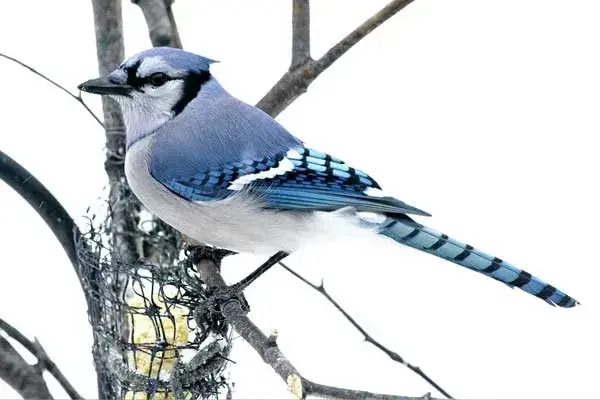
- Scientific name: Cyanocitta cristata
- Lifespan: 7 years
- Wingspan: 13–17 in
Blue jays are common songbirds native to eastern parts of the United States.
Both sexes look alike and have crests on their heads, black collars, blue upperparts, white underparts, sky-blue wings, and blue tails with black crossbars.
The crest on top of their heads can be used to indicate the birds’ mood – when agitated, the crest goes up and when frightened, the crest goes down.
Blue jays are North Georgia’s permanent residents and can be seen there throughout the year. They are widespread and commonly found in areas ranging from forests to city parks.
Blue jays are very noisy birds that will often mimic hawk sounds when approaching a feeding site to drive away other birds. They make a large variety of sounds and may even learn to mimic human speech.
Blue jays’ song is a mixture of clicks, chucks, whirrs, whines, liquid notes, and elements of other calls. Their alarm call is a loud, almost gull-like scream.
Source: G. McGrane, Public domain, via Wikimedia Commons
These highly intelligent birds mate for life and work together to build a nest for their young. When the female sits on the eggs, the male will feed and take care of her.
They are also omnivores that mostly feed on seeds, berries, nuts, and occasionally insects.
Blue jays are one of many common birds found in Pennsylvania, Maryland, North Texas, Florida, and Central Texas.
Cedar Waxwing

- Scientific name: Bombycilla cedrorum
- Lifespan: up to 8 years
- Wingspan: 9-12 in
Cedar waxwings are one of the most striking and handsome birds of Georgia.
These medium-sized songbirds have large heads and crests, black masks, and short necks and beaks. They have pale brown heads, soft gray wings, pale yellow bellies, and gray tails with bright yellow tips.
If they consume a lot of honeysuckle fruits while growing up, the tips of their tails will turn from yellow to orange.
Cedar waxwings are permanent residents in the mountains of north Georgia; as you move to the south, they can be only seen from fall to spring in the lowlands.
Cedar waxwings are classified as songbirds but have no song. Instead, they use several short and simple calls, a high-pitched “bzee” and a sighing whistle.
Source: G. McGrane, Public domain, via Wikimedia Commons
These yellow-tailed birds got their name from the waxy red tips on their secondary wing feathers.
Cedar waxwings are one of the few North American birds that can survive eating only fruit for several months. Scientists recorded cases of them becoming drunk from eating too much of the fermented fruit.
Cedar waxwings are monogamous and both partners will build a nest of grass, twigs, bark, and hair. The female will have a clutch of 4-5 eggs that she incubates while the male feeds her. After that, both parents take care of the young.
Tufted Titmouse
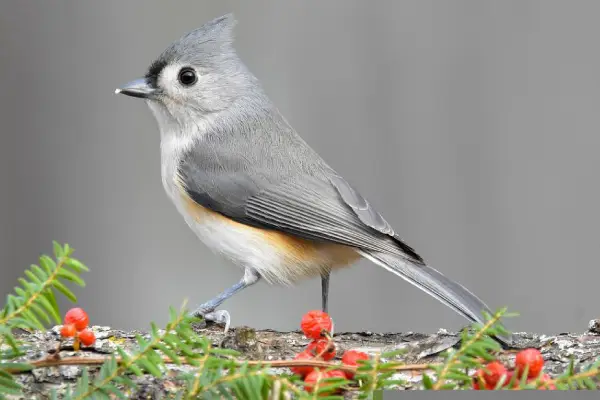
- Scientific name: Baeolophus bicolor
- Lifespan: 2 years
- Wingspan: 8-10 in
The tufted titmouse is one of Georgia’s most common songbirds.
It has gray plumage, fawn flanks, a crest on its head, black eyes, and a spot on its forehead.
The tufted titmouse is a permanent resident of North Georgia, common from forests and parks to suburbs of the state. The breeding season in the state lasts from March to May.
The song of a tufted titmouse is described as a series of 4 to 8 whistled notes that sound like “peter-peter-peter.” The most common call is nasal and mechanical “tsee-day-day-day.”
Source: G. McGrane, Public domain, via Wikimedia Commons
According to some estimates, there are over 8 million tufted titmice in existence today.
They are omnivores that mainly feed on berries, nuts, seeds, fruits, and insects. They are common visitors to bird feeders and will first scout a feeder from cover before flying in to grab a seed.
Tufted titmice are cavity nesters that will build their nests in tree holes, nest boxes, or even in old woodpecker nests. If they find snake skin, they might use it as a building material. Females will lay 5-8 white eggs with brown speckles.
Read More: What are some examples of bird eggs with brown speckles?
White-eyed Vireo
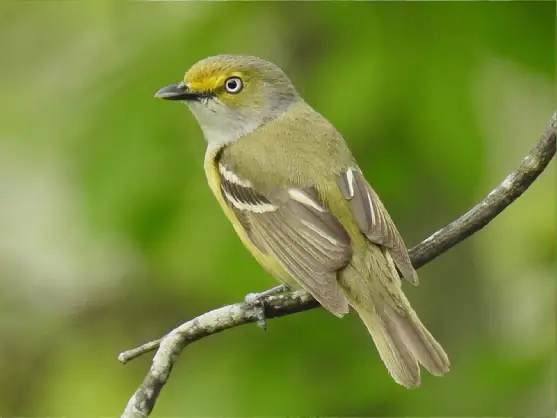
- Scientific name: Vireo griseus
- Lifespan: up to 11 years
- Wingspan: 6.7 in
White-eyed vireos are small songbirds named after their white irises.
They have olive-green upperparts, white underparts, yellow foreheads, green sides, gray necks, and dark wings.
White-eyed vireos are breeding residents of Northern Georgia and can be seen there from spring to fall, around woodlands and brushy forest undergrowths.
These shy birds love to stay in tree understory and out of sight but will sing the whole day to let you know they are there.
White-eyed vireos have a song that consists of rapid 6-7 notes that start and end with a sharp “chick“. They also have several calls, including short “zips” and harsh “mews“.
Source: G. McGrane, Public domain, via Wikimedia Commons
They are omnivores that mainly feed on insects during summer and add berries to their diets when the winter comes.
They have an interesting way of bathing – white-eyed vireos will rub their bodies against wet leaves in the morning.
They are one of many native birds of Florida; check the full list here.
Northern Cardinal

- Scientific name: Cardinalis cardinalis
- Lifespan: 3 years
- Wingspan: 10-12 in
Northern cardinals are one of the most common Georgia birds.
These medium-sized songbirds have short thick beaks and large crests.
Males are with bright red colors, stunning orange beaks, red crests on their heads, and black throats and faces; females are brown with head crests and with reddish wings and tails.
Northern cardinals are permanent residents of North Georgia and are common around woodlands, brushy fields, parks, backyards, and other urban areas of the state, year-round.
They have a 2-3-seconds-long song that consists of a loud string of clear down-slurred or two-parted whistles that sound like “cheer-cheer,” “birdie-birdie,” and “wheet-wheet.”
Source: G. McGrane, Public domain, via Wikimedia Commons
Northern cardinals’ most common call is a loud, metallic chip they use to chase other males entering their territories.
These birds are very territorial and aggressive – northern cardinals will even try to ferociously attack their reflections in the mirrors and windows.
They are also known as redbirds and they get their red color from the food they eat – if there are not enough carotenoids in their diet, they become brownish.
They are omnivores that feed on seeds, fruit, and insects.
Attract northern cardinals to your bird feeder by adding some sunflower seeds, peanut hearts, and millet.
American Robin

- Scientific name: Turdus migratorius
- Lifespan: 2 years
- Wingspan: 12-16 in
American robins are state birds of Connecticut, Michigan, and Wisconsin. These rather large songbirds were named after the not-so-closely related European robin.
Males have black heads, yellow beaks, and brick-red breasts; females have duller plumage and brown heads.
American robins are permanent residents of North Georgia and can be seen in the state throughout the year, especially around residential lawns and gardens, urban parks, pastures, and fragmented forests.
Their breed lasts from April to July and they will have 2-3 clutches of 3-4 light blue eggs per year.
American robins have a song that is described as a “cheery” carol consisting of a string of 10 or so clear whistles. They also use a sharp “yeep” alarm call or a mumbled “tuk” when communicating with one another.
Source: G. McGrane, Public domain, via Wikimedia Commons
These birds will also sing when storms approach and when they have passed.
Outside of the breeding season, American robins like to form large flocks of birds, sometimes up to 10,000 individuals!
They are omnivores that feed on eat invertebrates, especially earthworms, and fruit.
Gray Catbird
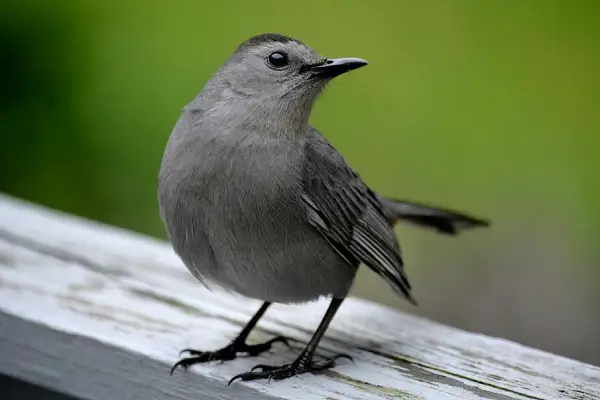
- Scientific name: Dumetella carolinensis
- Lifespan: up to 17 years
- Wingspan: 8.7-11.8 in
Gray catbirds are long-legged songbirds with broad, rounded wings.
They are gray overall and have black caps and rufous vents.
Gray catbirds are birds of North Georgia that can be seen there during the breeding season, from spring to fall. They are common around forests and other habitats ranging from woodlands to suburban gardens.
Gray catbirds are unmistakable for their cat-like call after which they got their name. They have a song that consists of a long, irregular succession of musical and mechanical notes and phrases.
Source: G. McGrane, Public domain, via Wikimedia Commons
Just like mockingbirds, gray catbirds can mimic the songs of other birds. However, mockingbirds sing perched on trees while catbirds sing from inside a bush or small tree and are often hidden by the vegetation.
You might be able to attract them by making “pishing” sounds.
These fearless birds are not scared of invaders and will often attack and peck predators that come close to their nests.
Gray catbirds will also destroy brood parasitic eggs laid in their nests. These songbirds are omnivores and feed on insects and berries.
Attract gray catbirds to your backyard by placing fruit feeders with grape jelly, sliced oranges, and apples.
Summer Tanager
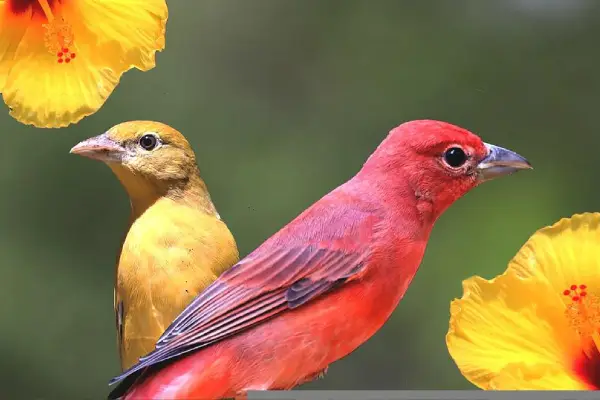
- Scientific name: Piranga rubra
- Lifespan: up to 5 years
- Wingspan: 11-12 in
These medium-sized American songbirds have large bodies and heads and thick blunt-tipped beaks. Males have bright red plumage while females are olive-green above and yellowish below.
Summer tanagers are breeding residents of North Georgia and are widespread there around forests, woodlands, and riparian areas.
Look for summer tanagers from April to early October before they migrate to wintering grounds in Mexico, Central, and South America.
Despite having one of the most striking colors in the state, these birds might be hard to spot as they prefer to forage high in the tree canopy.
Summer tanagers have a song that consists of a series of robin-like musical phrases; they also have sharp “pik-i-tuk-i-tuk” calls.
Source: G. McGrane, Public domain, via Wikimedia Commons
They are omnivores that mainly feed on insects, especially bees and wasps, but might also consume some fruit outside of breeding season.
These beautiful birds will have a clutch of 3-4 pale blue to pale green eggs with brown markings. Females will incubate the eggs while the males feed them. Both partners will take care of the chicks.
Black-and-white Warbler

- Scientific name: Mniotilta varia
- Lifespan: up to 11 years
- Wingspan: 7-9 in
Black-and-white warblers are an early sign that the spring is near.
If you are a beginner birder, these birds are a good choice, as black-and-white warblers are easy to see and recognize. Their song, reminiscent of a rusty wheel turning, is hard to miss.
These small songbirds have fairly long, slightly downcurved beaks and short tails. Recognize black-and-white warblers by their black and white striped plumage that is white below and black wings with two wide white wing bars.
Black-and-white warblers are breeding residents in the North Georgia mountains and can be seen there from spring to fall.
They have a high-pitched “wee-see” song that lasts about three seconds and is repeated around 6 times. Black-and-white warblers also have two calls, a hard “tick” and a soft, thin “fsss.”
Source: G. McGrane, Public domain, via Wikimedia Commons
Look for them around woods and in urban areas.
These birds can be very territorial and aggressive during their breeding season, like all warblers – they’ll attack and fight with other species that enter their territory.
Black-and-white warblers are insectivores (carnivores) that mostly feed on insects, caterpillars, beetles, ants, flies, bugs, and some spiders.
Common Yellowthroat

- Scientific name: Geothlypis trichas
- Lifespan: up to 11 years
- Wingspan: 5.9–7.5 in
Common yellowthroats are well-known songbirds of Georgia.
People call these tiny warblers with rounded heads and medium-long tails “yellow bandits,” due to their extravagant looks.
Males have brown plumage, yellow throats, yellow underparts, and black facial masks with white borders. Females look similar and have paler underparts and have no masks.
Common yellowthroats are common around riparian habitats, marshes, and wet fields of North Georgia from spring to fall. In southerner parts of the state, they are present year-round.
The song of common yellowthroats is a loud “twichety twichety twichety twich,” while their call is a soft “jip.”
Source: G. McGrane, Public domain, via Wikimedia Commons
They will spend much of their time darting low in dense thickets and fields, catching small insects and spiders.
Common yellowthroats love to nest around low areas of vegetation. They will build a cup-shaped nest and lay 3–5 eggs with both parents feeding the chicks.
Eastern Towhee
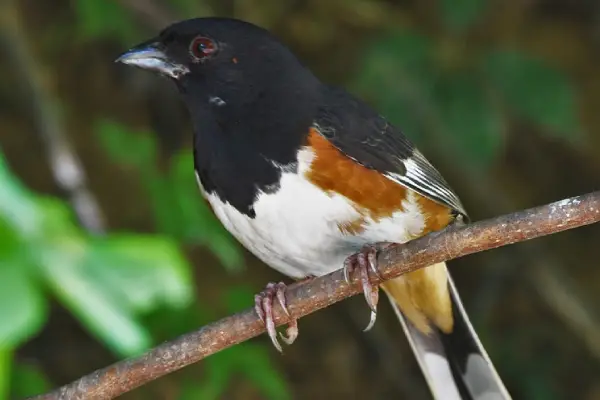
- Scientific name: Pipilo erythrophthalmus
- Lifespan: up to 12 years
- Wingspan: 8-12 in
Eastern towhees are large and conspicuous sparrows with black upperparts, white underparts, rufous flanks, white wing stripes, and red eyes. Females look like males; they are brown instead of black.
Eastern towhees are permanent residents of northern parts of Georgia and can be seen around woodland habitats, forests, and gardens year-round.
Although hard to spot as they love to stay in thick undergrowth, once you learn their song, you will recognize them with ease.
Eastern towhees are famous for their short, three-note “drink-your-tea-ee-ee” song that ends in a higher-pitched trill. They also have a sharp, loud “che-wink” or “tow-whee” call.
Source: Eastern Towhee, Public domain, via Wikimedia Commons
They spend most of the time on the ground, foraging through leaves using both feet.
Eastern towhees nest on or close to the ground, usually under bushes or in brush piles. They will have two broods per year with 2-6 eggs. The species is monogamous.
Eastern towhees are omnivores and their diet mainly consists of seeds, fruits, spiders, and insects.
Ruby-throated Hummingbird
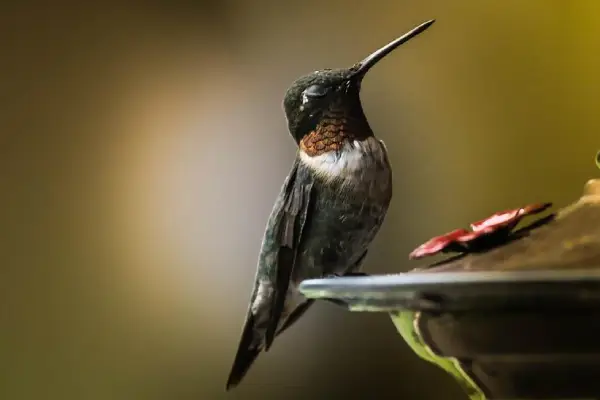
- Scientific name: Archilochus colubris
- Lifespan: 3-5 years
- Wingspan: 4.25-4.5 in
Ruby-throated hummingbirds are the only hummingbird species that nest in Georgia.
They are sexually dimorphic: males have metallic emerald green upperparts, grayish-white underparts, black wings, and a gorget (throat patch) of iridescent ruby red. Their tails are forked.
Females are larger than males and have white throats.
They also have long and narrow beaks that are perfect for sipping nectar from deep inside flowers; the beaks are black and take almost ¼ of their entire body length!
Ruby-throated hummingbirds are summer residents that can be seen from spring to fall in North Georgia. They breed around deciduous and pine forests and forest edges, orchards, and gardens.
These tiny birds with long beaks are migratory and winter in Florida, Mexico, and Central America.
Ruby-throated hummingbirds have several calls: they make squeaky “chirps” to warn others when entering their territory and quick “tik-tik” sounds with wings when courting females.
Source: Unknown author, Public domain, via Wikimedia Commons
They move very quickly, around 25 mph, and will beat their wing over 50 times per second.
Ruby-throated hummingbirds are mostly solitary, except during the breeding season which is rather short.
Attract these incredible birds with orange-red necks to your backyard by setting up hummingbird feeders or planting tubular flowers. They are quite bold and might even feed at hanging plants and feeders on your porch or next to your windows!
Belted Kingfisher
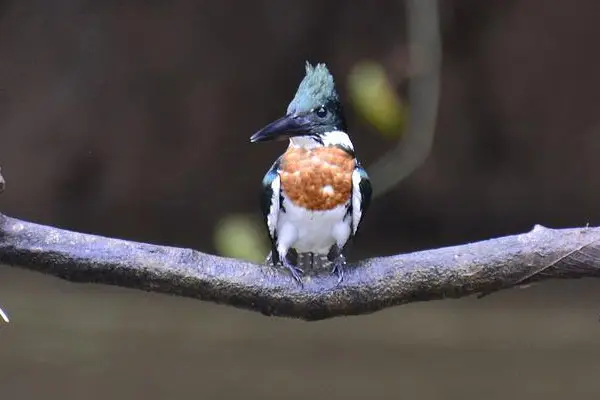
- Scientific name: Megaceryle alcyon
- Lifespan: 6-14 years
- Wingspan: 20 in
These rather large and conspicuous water kingfishers have large heads, long and heavy beaks, and shaggy crests on top.
Males are slate blue with white underparts, while the females have orange patches on their bellies and flanks and are a lot brighter than males – brighter female plumage is not very common among birds.
Usually found along lakes, rivers, streams, marshes, and ponds, belted kingfishers are North Georgia birds that can be seen there throughout the year.
The alarm calls of belted kingfishers are harsh mechanical rattles and occasionally screams.
Source: Unknown author, Public domain, via Wikimedia Commons
When the breeding season comes, they become very territorial – males will often charge at and chase intruders away.
Belted kingfishers are carnivores that dive to catch fish and crayfish with their heavy beaks; they also feed on mollusks, crustaceans, amphibians, and lizards.
They can’t digest bones, so just like owls, they regurgitate the undigested pieces as pellets.
Red-bellied Woodpecker
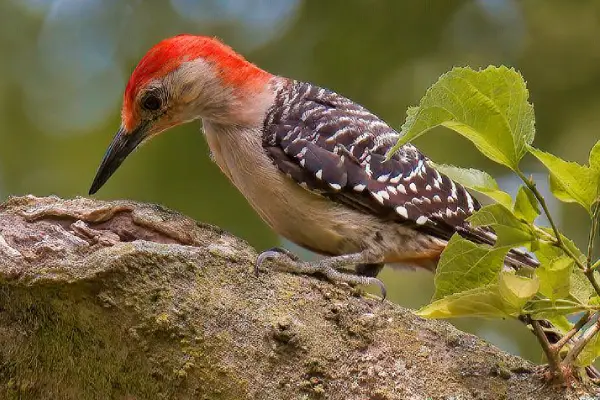
- Scientific name: Melanerpes carolinus
- Lifespan: up to 12 years in the wild
- Wingspan: 15-18 in
Red-bellied woodpeckers are medium-sized birds found in the eastern parts of the United States.
Both sexes look similar and have barred backs, red hoods, plain faces and underparts, and inconspicuous red belly patches.
Red-bellied woodpeckers are widespread in North Georgia; common in areas from forests to suburbs of the state, year-round.
These woodpeckers are rather noisy and use several vocalizations.
Red-bellied woodpeckers’ most common call is a high-pitched “kwill” or “churr.” They will often make drumming sounds by tapping with their beaks on hollow trees or roofs to attract females.
Source: G. McGrane, Public domain, via Wikimedia Commons
Males will start digging their nests in dead tree trunks and softly tap on the tree bark to attract females; if interested, they will join them, and the pair will finish the nest together.
Females will then lay 3-5 eggs that both parents incubate.
They are omnivores that mainly consume insects, fruits, nuts, and seeds.
Attract red-bellied woodpeckers to your backyard by adding sunflower seeds and different nuts to your bird feeder; add suet during winter as they are fond of it.
Eastern Screech Owl

- Scientific name: Megascops asio
- Lifespan: up to 14 years
- Wingspan: 18-24 in
Eastern screech owls are the most common owls in Georgia.
They are rather small owls with large heads, rounded wings, and short and square tails.
There are two morphs, a rufous and a gray, with either rusty or dark gray plumage with streaked underparts. These owls have small ear tufts, yellow eyes, and horn-colored beaks.
Eastern screech owls are permanent residents of North Georgia and can be seen around woodlands, forests, and suburbs of the state throughout the year.
Eastern screech owls are rather vocal; both sexes sing. Their most common song is a “bounce song,” an even-pitched trill. They also have soft low hoots, loud barking alarm calls, and screeches that adults emit when defending nests.
Source: Jonathon Jongsma, CC BY-SA 3.0, via Wikimedia Commons
Their breeding season begins around March and lasts until late May. They are cavity nesters and use naturally occurring cavities or woodpecker cavities. Females lay 2-8 eggs; males will feed their partners while they incubate the eggs.
Eastern screech owls are carnivores and feed on insects, small mammals, and some birds.
If you go looking for them, remember that screech owls are nocturnal birds.
You can read more about other nighttime animals found in GA here.
Black Vulture

- Scientific name: Coragyps atratus
- Lifespan: 10 years in the wild
- Wingspan: 52-66 in
Aggressive and large, these Georgian birds of prey have black plumage, bare black heads, chalky white feet and legs, short, hooked beaks, and white wing patches that can be seen during flight.
Black vultures are often mistaken for turkey vultures; the main difference is the smaller size and shorter wings and tails in black vultures.
Black vultures are permanent residents of North Georgia and can be seen there around open areas and woods, throughout the year.
Despite being a rather quiet species, black vultures are known to make hissing sounds when feeding and fighting.
These highly gregarious birds might form large communal roosts at night with turkey vultures.
They are carnivores and primarily feed on carrion; black vultures may also hunt and eat small reptiles, birds, and mammals. They will spend most of their day looking for food.
Black vultures are monogamous and pairs are believed to mate for life – both the male and female will take turns incubating their eggs.
Read More: 25 examples of birds that sing at night in Georgia
Red-shouldered Hawk
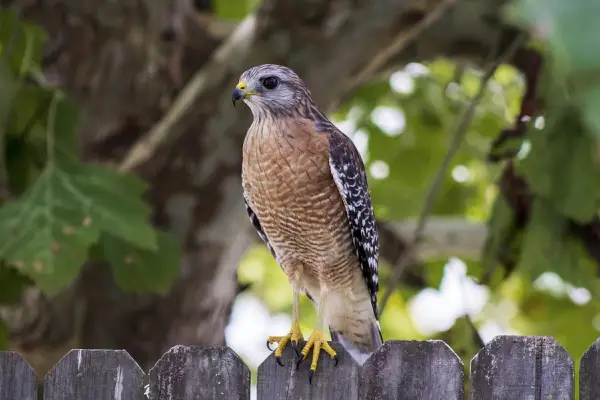
- Scientific name: Buteo lineatus
- Lifespan: 15-19 years
- Wingspan: 35-50 in
These medium-sized hawks are very vocal species.
Red-shouldered hawks can be identified by their bold checkered wings and tails, brick-red shoulder patches, and light russet barrings on their underparts.
Red-shouldered hawks are birds of North Georgia found throughout the year around woodlands and forests of the state, often near water. Their breeding season usually lasts from April to July.
They are monogamous and usually have a clutch of 2-4 eggs that the female incubates while the male feeds her.
Red-shouldered hawks have a loud, piercing “kee-yeeear” call and can be often heard before being spotted. When the breeding season comes, they become extremely vocal.
Source: G. McGrane, Public domain, via Wikimedia Commons
Red-shouldered hawks will perch on tree branches and utility wires and scan the area. As they spot their prey, they will swoop down and snatch it from the ground or water surface.
These raptors are carnivores and feed on small mammals, birds, reptiles, amphibians, and crayfish.
Green Heron
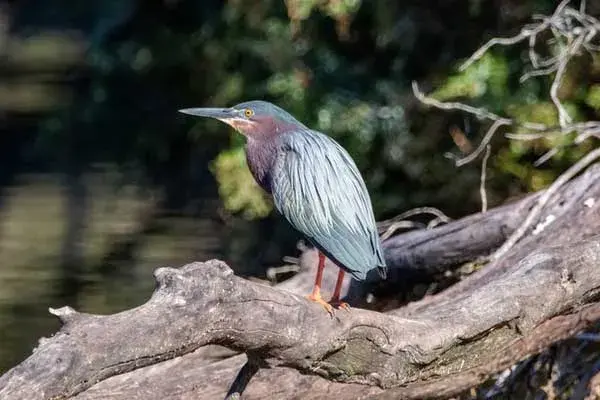
- Scientific name: Butorides virescens
- Lifespan: up to 8 years
- Wingspan: 25-26 in
These small dark herons with dark reddish necks, greenish backs, red-orange legs, and dark beaks are common in the state of Georgia.
Green herons are breeding residents of North Georgia and can be seen there during summer, around marshes, streams, and pond edges.
Green herons can be also identified by their loud and sudden “kyow” call.
They are rare bird species that use tools, often leaving bread crusts, insects, and feathers on the surface of the water to attract small fish, patiently waiting for the fish to come, and snatching it with their dagger-like bills.
Green herons also feed on crayfish, other crustaceans, insects, grasshoppers, frogs, rodents, and even snakes.
American Coot
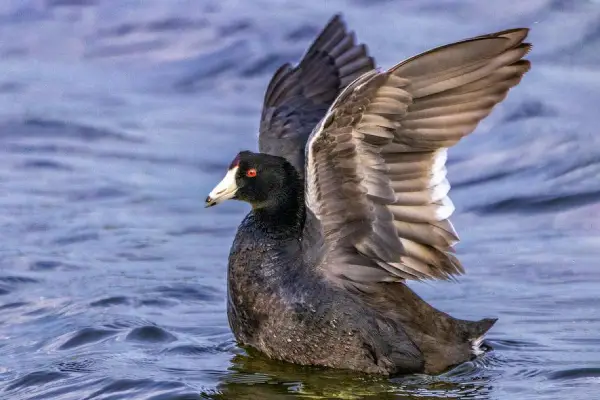
- Scientific name: Fulica americana
- Lifespan: around 9 years
- Wingspan: 23-25 in
American coots are small chickenlike birds with rounded heads, sloping beaks, short wings and tails, and large feet.
They are black with bright white beaks, red irises, and green legs.
American coots are winter residents of North Georgia, common around wetlands of the state. They will migrate to their breeding grounds in northern parts of the USA and Canada to breed.
Male American coots have alarm calls that sound like “puhlk” while females have “poonk” alarm calls.
They are common around large flocks together with ducks and geese.
Although they resemble ducks, American coots are only distantly related to them. And unlike the webbed feet of ducks, American coots have lobed scales on their legs and toes that allow them to walk easily on land.
American coots are omnivores that feed on algae and other plants; they will also consume small vertebrates such as fish and tadpoles, and occasionally marsh bird eggs.
Mourning Dove

- Scientific name: Zenaida macroura
- Lifespan: 2 years in the wild
- Wingspan: 12 in
Mourning doves are one of the most widespread birds in North America.
Named after the sad cooing sounds they make while singing, you will recognize them by their broad wings, rounded heads, and brown-gray plumage overall with black spots on the wings.
Mourning doves are permanent residents of North Georgia and can be seen around open areas, forest edges, farms, parks, and urban areas throughout the year. They tend to avoid swamps and thick forests.
Mourning doves have several vocalizations: distinctive “coo-woo-woo” calls when attracting females, soft greeting “ork” calls, and short “roo-oo” alarm calls.
Source: Jonathon Jongsma, CC BY-SA 3.0, via Wikimedia Commons
They are excellent at breeding and can raise up to 12 young per year. Mourning doves are monogamous and both parents incubate the eggs and raise the young.
They are omnivores with seeds making 99% of their diet; they might also consume some insects or snails.
Bufflehead
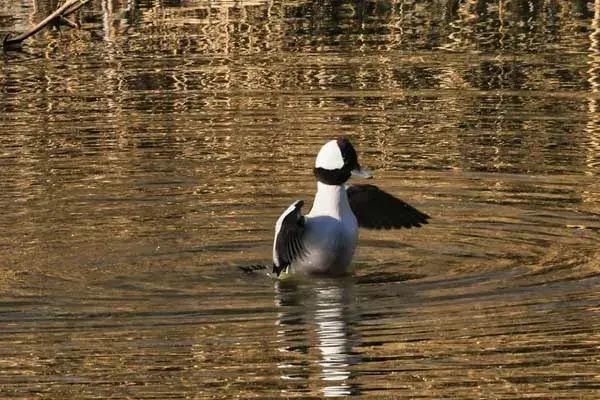
- Scientific name: Bucephala albeola
- Lifespan: 2.5 years
- Wingspan: 22 in
Buffleheads are one of the smallest diving ducks in North America with their weight ranging from 9.5 to 19.4 oz.
They can be identified by their white bodies, black backs, glossy black-green heads, and large white patches at the back of their heads.
Buffleheads are non-breeding residents of North Georgia’s wetlands and can be seen there from fall to spring. They breed in the wooded lakes and ponds of Alaska and Canada.
Some of these stunning birds might even end up in Hawaii as part of their migration.
You will find them spending half the time underwater while foraging. Look for birds with a gray bill and pink legs and feet.
Buffleheads are monogamous birds, staying with the same partner for many years.
They are omnivorous and feed on aquatic insects, crustaceans, mollusks, and some plants.
Read More: More examples of white-headed ducks
Wood Duck
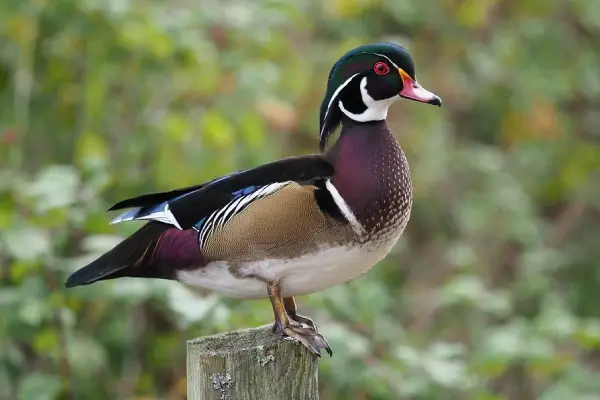
- Scientific name: Aix sponsa
- Lifespan: 3-4 years
- Wingspan: 26-29 in
Also known as Carolina ducks, wood ducks are medium-sized perching ducks of the eastern US.
Males are stunning and have red eyes, crests, and multicolored plumage; females are grayish brown and have white eyerings and blue speculum.
Wood ducks are permanent residents of North Georgia and can be seen year-round in different river riparian habitats, wooden marshes, and parks.
Listen for the male’s rising whistle “jeee” call or the female’s drawn-out, rising squeal that sounds like “do weep do weep.”
Source: Jonathon Jongsma, CC BY-SA 3.0, via Wikimedia Commons
This species usually nests in cavities in trees close to water; if you put a nesting box, you might be able to attract a pair.
Wood ducks have a clutch of 7-15 white-tan eggs and they are the only North American ducks that can produce two broods in one season.
They are omnivores and feed on nuts, seeds, vegetables, berries, and insects.
Summary
This concludes our list of birds of North Georgia.
Examples include several types of songbirds, raptors, woodpeckers, hawks, owls, ducks, and many others.
Georgia is known for its rich wildlife – there are over 400 species of birds there!
Next time you see any of these birds in person, you should be able to recognize them with ease!
And if you enjoyed our article, here are our other popular reads on birds: Examples of songbirds of Minnesota and Examples of big white birds